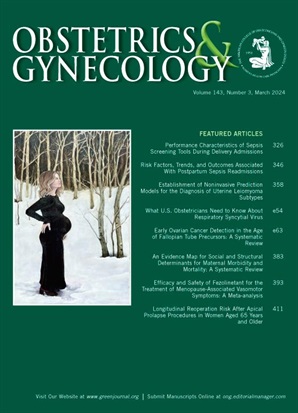Relationship Between Third-Trimester Low Maternal Blood Pressure and Small-for-Gestational-Age Birth Weight in Pregnant Individuals With Mild Chronic Hypertension.
IF 4.7
2区 医学
Q1 OBSTETRICS & GYNECOLOGY
引用次数: 0
Abstract
OBJECTIVE To estimate the association between third-trimester maternal low blood pressure (BP) and delivery of a neonate with small-for-gestational-age (SGA) birth weight in patients treated for mild chronic hypertension. METHODS This is a secondary analysis of the CHAP (Chronic Hypertension and Pregnancy) study, which randomized pregnant participants with mild chronic hypertension to treatment to achieve goal BP below 140/90 mm Hg compared with usual care. We calculated mean systolic and diastolic BPs between 28 and 34 weeks of gestation and excluded those with systolic BP of 140 mm Hg or higher or diastolic BP of 90 mm Hg or higher. We defined low BP as mean systolic BP below 110 and mean diastolic BP below 70 mm Hg or mean arterial pressure below 80 mm Hg and compared those individuals with participants with mean systolic BP of 110-139 mm Hg or mean diastolic BP of 71-89 mm Hg or both or mean arterial pressure of 80 mm Hg or higher. Our primary outcome was delivery of a neonate with SGA birth weight (birth weight below the 5th percentile). Logistic regression estimated the association between low BP and SGA birth weight, and adjusted odds ratios (aORs) and 95% CIs were reported. RESULTS Of 2,408 CHAP participants, 1,205 (50.0%) met analysis criteria. Of those 1,205, 31 (2.6%) had low BP and 1,174 (97.4%) had mean BP 110/70-139/89 mm Hg; 33 (2.7%) had mean arterial pressure below 80 mm Hg, and 1,172 (97.3%) had mean arterial pressure of 80 mm Hg or higher. Having a neonate with SGA birth weight below the 5th percentile occurred in 62 participants (5.1%): 1 of the 31 (3.2%) with BP below 110/70 mm Hg and 1 of the 33 (3.0%) with mean arterial pressure below 80 mm Hg. There was no significant association between delivery of a neonate with SGA birth weight less than the 5th percentile and low BP by either mean systolic BP and mean diastolic BP (aOR 0.46, 95% CI, 0.06-3.58) or mean arterial pressure (aOR 0.53, 95% CI, 0.07-4.01). We found a nonlinear relationship between mean arterial pressure and delivery of a neonate with SGA birth weight less than the 5th percentile, and, as mean arterial pressure decreased, there was lower probability of having a neonate with SGA birth weight (P=.02). CONCLUSION Pharmacologic treatment of mild chronic hypertension infrequently results in low BP and does not appear to be associated with delivery of a neonate with SGA birth weight less than the 5th percentile for birth weight.轻度慢性高血压孕妇妊娠晚期低血压与小胎龄出生体重的关系
目的评估轻度慢性高血压患者妊娠晚期产妇低血压(BP)与出生体重小于胎龄(SGA)新生儿的关系。方法:本研究是对CHAP(慢性高血压和妊娠)研究的二次分析,该研究将患有轻度慢性高血压的孕妇随机分组,与常规治疗相比,治疗目标血压低于140/90 mm Hg。我们计算了妊娠28 - 34周的平均收缩压和舒张压,排除了收缩压为140毫米汞柱或更高或舒张压为90毫米汞柱或更高的患者。我们将低血压定义为平均收缩压低于110,平均舒张压低于70毫米汞柱或平均动脉压低于80毫米汞柱,并将这些个体与平均收缩压为110-139毫米汞柱或平均舒张压为71-89毫米汞柱或两者均为或平均动脉压为80毫米汞柱或更高的参与者进行比较。我们的主要结局是新生儿出生体重SGA(出生体重低于第5百分位)。Logistic回归估计了低血压和SGA出生体重之间的关系,并报道了校正优势比(aORs)和95% ci。结果2408例CHAP参与者中,有1205例(50.0%)符合分析标准。在1205例患者中,31例(2.6%)血压较低,1174例(97.4%)平均血压为110/70-139/89 mm Hg;33例(2.7%)平均动脉压低于80 mm Hg, 1172例(97.3%)平均动脉压高于80 mm Hg。和SGA新生儿出生体重低于62年第五百分位发生在参与者(5.1%):31(3.2%)与BP的第1低于110/70毫米汞柱和1 33(3.0%)的平均动脉压力低于80毫米汞柱之间没有明显联系。交付SGA的新生儿出生体重少于5百分位和低BP通过平均收缩压和平均舒张压(优势比0.46,95%可信区间,0.06 - -3.58)或平均动脉压(优势比0.53,95%可信区间,0.07 - -4.01)。我们发现平均动脉压与出生体重小于第5个百分位的新生儿的分娩之间存在非线性关系,并且随着平均动脉压的降低,出生体重为SGA的新生儿的概率越低(P= 0.02)。结论:轻度慢性高血压的药物治疗很少导致低血压,并且似乎与出生体重小于出生体重第5百分位的新生儿SGA分娩无关。
本文章由计算机程序翻译,如有差异,请以英文原文为准。
求助全文
约1分钟内获得全文
求助全文
来源期刊

Obstetrics and gynecology
医学-妇产科学
CiteScore
11.10
自引率
4.20%
发文量
867
审稿时长
1 months
期刊介绍:
"Obstetrics & Gynecology," affectionately known as "The Green Journal," is the official publication of the American College of Obstetricians and Gynecologists (ACOG). Since its inception in 1953, the journal has been dedicated to advancing the clinical practice of obstetrics and gynecology, as well as related fields. The journal's mission is to promote excellence in these areas by publishing a diverse range of articles that cover translational and clinical topics.
"Obstetrics & Gynecology" provides a platform for the dissemination of evidence-based research, clinical guidelines, and expert opinions that are essential for the continuous improvement of women's health care. The journal's content is designed to inform and educate obstetricians, gynecologists, and other healthcare professionals, ensuring that they stay abreast of the latest developments and best practices in their field.
 求助内容:
求助内容: 应助结果提醒方式:
应助结果提醒方式:


